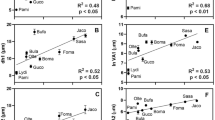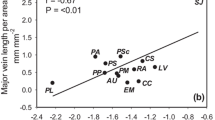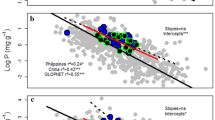Abstract
Key message
Leaf density links the resistance to mechanical and hydraulic stress in Mediterranean shrubs as it is associated with the water potential at turgor loss and the moduli of elasticity and strength.
Abstract
Understanding the patterns of hydraulic and mechanical trait variation in vascular plants is critical to predicting species’ stress tolerance. Although previous work has shown that hydraulic and mechanical traits are decoupled in stems, there is little information available for leaves, which are organs more diversified in structure, function, and possibly drought tolerance strategies across habitats. We tested for coordination between leaf hydraulic traits related to drought tolerance and the mechanical resistance of leaves, for 17 shrub species from the arid and semiarid vegetation of the California Floristic Province. Bayesian and phylogenetic correlations showed that across species, hydraulic and mechanical traits both had strong associations with the water potential at turgor loss, and with leaf tissue density. However, leaf maximum hydraulic conductance and the water potential at 50% and 80% loss of hydraulic conductance were statistically independent of two key mechanical traits, the leaf modulus of elasticity and leaf structural strength. Our results suggest that leaf biomechanical traits, which reflect construction costs and contribute to leaf longevity, are decoupled from hydraulic capacity and safety. The independence of hydraulic and mechanical protection in leaves enables a wide range of trait combinations in leaves, which would increase their adaptive potential across ecosystems.





Similar content being viewed by others
References
Anderegg WR, Klein T, Bartlett M, Sack L, Pellegrini AF, Choat B, Jansen S (2016) Meta-analysis reveals that hydraulic traits explain cross-species patterns of drought-induced tree mortality across the globe. Proc Natl Acad Sci USA 113:5024–5029
Baas P, Ewers FW, Davis SD, Wheeler EA (2004) Evolution of xylem physiology. In: Hemsley AR, Poole I (eds) The evolution of plant physiology. Elsevier Academic Press, London, pp 273–295
Balsamo RA, Vander Willigen C, Bauer AM, Farrant J (2006) Drought tolerance of selected eragrostis species correlates with leaf tensile properties. Ann Bot 97:985–991
Bartlett MK, Scoffoni C, Sack L (2012a) The determinants of leaf turgor loss point and prediction of drought tolerance of species and biomes: a global meta-analysis. Ecol Lett 15:393–405
Bartlett MK, Scoffoni C, Ardy R, Zhang Y, Sun S, Sack L (2012b) Rapid determination of comparative drought tolerance traits: using an osmometer to predict turgor loss point. Methods Ecol Evol 3:880–888
Bartlett MK, Zhang Y, Kreidler N et al (2014) Global analysis of plasticity in turgor loss point, a key drought tolerance trait. Ecol Lett 17:1580–1590
Bartlett MK, Zhang Y, Yang J et al (2016) Drought tolerance as a driver of tropical forest assembly: resolving spatial signatures for multiple processes. Ecology 97:503–514
Blackman CJ, Brodribb TJ, Jordan GJ (2010) Leaf hydraulic vulnerability is related to conduit dimensions and drought resistance across a diverse range of woody angiosperms. New Phytol 188:1113–1123
Blackman CJ, Gleason SM, Chang Y, Cook AM, Laws C, Westoby M (2014) Leaf hydraulic vulnerability to drought is linked to site water availability across a broad range of species and climates. Ann Bot 114:435–440
Blackman CJ, Aspinwall MJ, Resco de Dios V, Smith RA, Tissue DT (2016) Leaf photosynthetic, economics and hydraulic traits are decoupled among genotypes of a widespread species of eucalypt grown under ambient and elevated CO2. Funct Ecol 30:1491–1500
Blonder B, Salinas N, Bentley LP et al (2018) Structural and defensive roles of angiosperm leaf venation network reticulation across an Andes–Amazon elevation gradient. J Ecol 106:1683–1699
Brodribb TJ, Jordan GJ (2008) Internal coordination between hydraulics and stomatal control in leaves. Plant Cell Environ 31:1557–1564
Brodribb TJ, Holbrook NM, Edwards EJ, Gutierrez MV (2003) Relations between stomatal closure, leaf turgor and xylem vulnerability in eight tropical dry forest trees. Plant Cell Environ 26:443–450
Brodribb TJ, Bienaimé D, Marmottant P (2016) Revealing catastrophic failure of leaf networks under stress. Proc Natl Acad Sci USA 113:4865–4869
Brodribb TJ, Carriqui M, Delzon S, Lucani C (2017) Optical measurement of stem xylem vulnerability. Plant Physiol 174:2054–2061
Buckley TN, John GP, Scoffoni C, Sack L (2015) How does leaf anatomy influence water transport outside the xylem?. Plant Physiol 168:1616–1635
Burge DO, Erwin DM, Islam MB, Kellermann J, Kembel SW, Wilken DH, Manos PS (2011) Diversification of Ceanothus (Rhamnaceae) in the California Floristic Province. Int J Plant Sci 172:1137–1164
Burnham KP, Anderson DR (2002) Model selection and multimodel inference, 2nd edn. Springer, New York
Choat B, Jansen S, Brodribb TJ et al. (2012) Global convergence in the vulnerability of forests to drought. Nature 491:752–755
Cooper WS (1922) The broad-sclerophyll vegetation of California: an ecological study of the chaparral and its related communities (319). Carnegie Institution of Washington, Washington
Damián X, Fornoni J, Domínguez CA, Boege K (2018) Ontogenetic changes in the phenotypic integration and modularity of leaf functional traits. Funct Ecol 32:234–244
Davis SD, Ewers FW, Sperry JS, Portwood KA, Crocker MC, Adams GC (2002) Shoot dieback during prolonged drought in Ceanothus (Rhamnaceae) chaparral of California: a possible case of hydraulic failure. Am J Bot 89:820–828
Engelbrecht BMJ, Comita LS, Condit R (2007) Drought sensitivity shapes species distribution patterns in tropical forests. Nature 447:80–82
Fan ZX, Sterck F, Zhang SB, Fu PL, Hao GY (2017) Tradeoff between stem hydraulic efficiency and mechanical strength affects leaf–stem allometry in 28 Ficus tree species. Front Plant Sci 8:1619
Gere JM, Goodno BJ (2009) Mechanics of materials. Cengage Learning, Mason
Givnish TJ, Pires JC, Graham SW et al (2005) Repeated evolution of net venation and fleshy fruits among monocots in shaded habitats confirms a priori predictions: evidence from an ndhF phylogeny. Proc R Soc Lond B Biol Sci 272:1481–1490
Gleason SM, Westoby M, Jansen S et al (2016) Weak tradeoff between xylem safety and xylem-specific hydraulic efficiency across the world’s woody plant species. New Phytol 209:123–136
Grime JP (1979) Plant strategies and vegetation processes. John Wiley & Sons, UK
Grime JP, Thompson K, Hunt R et al (1997) Integrated screening validates primary axes of specialisation in plants. Oikos 79:259–281
Hacke UG, Sperry JS, Pockman WT, Davis SD, McCulloh KA (2001) Trends in wood density and structure are linked to prevention of xylem implosion by negative pressure. Oecologia 126:457–461
Jacobsen AL, Ewers FW, Pratt RB, Paddock WA, Davis SD (2005) Do xylem fibers affect vessel cavitation resistance? Plant Physiol 139:546–556
Jacobsen AL, Pratt RB, Ewers FW, Davis SD (2007) Cavitation resistance among 26 chaparral species of southern California. Ecol Monogr 77:99–115
Jacobsen AL, Pratt RB, Davis SD, Ewers FW (2008) Comparative community physiology: non-convergence in water relations among three semi-arid shrub communities. New Phytol 180:100–113
Jarosz AF, Wiley J (2014) What are the odds? A practical guide to computing and reporting Bayes Factors. The Journal of Problem Solving 7:1, Article 2
John GP, Scoffoni C, Buckley TN, Villar R, Poorter H, Sack L (2017) The anatomical and compositional basis of leaf mass per area. Ecol Lett 20:412–425
Jones HG, Sutherland RA (1991) Stomatal control of xylem embolism. Plant Cell Environ 14:607–612
Kawai K, Okada N (2016) How are leaf mechanical properties and water-use traits coordinated by vein traits? A case study in Fagaceae. Funct Ecol 30:527–536
Kursar TA, Engelbrecht BMJ, Burke A, Tyree MT, Omari EI, Giraldo B JP (2009) Tolerance to low leaf water status of tropical tree seedlings is related to drought performance and distribution. Funct Ecol 23:93–102
Lachenbruch B, McCulloh KA (2014) Traits, properties, and performance: how woody plants combine hydraulic and mechanical functions in a cell, tissue, or whole plant. New Phytol 204:747–764
Lambers H, Poorter H (1992) Inherent variation in growth rate between higher plants: a search for physiological causes and ecological consequences. Adv Ecol Res 23:187–261
Li L, McCormack ML, Ma C, Kong D, Zhang Q, Chen X, Niinemets U, Guo D (2015) Leaf economics and hydraulic traits are decoupled in five species-rich tropical-subtropical forests. Ecol Lett 18:899–906
Li X, Blackman CJ, Choat B, Duursma RA, Rymer PD, Medlyn BE, Tissue DT (2018) Tree hydraulic traits are co-ordinated and strongly linked to climate-of-origin across a rainfall gradient. Plant Cell Environ 41:646–660
Markesteijn L, Poorter L, Bongers F, Paz H, Sack L (2011) Hydraulics and life history of tropical dry forest tree species: coordination of species’ drought and shade tolerance. New Phytol 191:480–495
McMahon T (1973) Size and shape in biology. Science 179:1201–1204
Mencuccini M, Grace J, Fioravanti M (1997) Biomechanical and hydraulic determinants of tree structure in Scots pine: anatomical characteristics. Tree Physiol 17:105–113
Mencuccini M, Minunno F, Salmon Y, Martínez-Vilalta J, Hölttä T (2015) Coordination of physiological traits involved in drought-induced mortality of woody plants. New Phytol 208:396–409
Méndez-Alonzo R, Paz H, Cruz-Zuluaga R, Rosell JA, Olson ME (2012) Coordinated evolution of leaf and stem economics in tropical dry forest trees. Ecology 93:2397–2406
Méndez-Alonzo R, Ewers FW, Sack L (2013) Ecological variation in leaf biomechanics and its scaling with tissue structure across three mediterranean-climate plant communities. Funct Ecol 27:544–554
Méndez-Alonzo R, López-Portillo J, Moctezuma C, Bartlett MK, Sack L (2016) Osmotic and hydraulic adjustment of mangrove saplings to extreme salinity. Tree physiol 36:562–1572
Nardini A, Pedà G, Rocca NL (2012) Trade-offs between leaf hydraulic capacity and drought vulnerability: morpho-anatomical bases, carbon costs and ecological consequences. New Phytol 196:788–798
Nardini A, Gullo MA, Trifilò P, Salleo S (2014) The challenge of the Mediterranean climate to plant hydraulics: responses and adaptations. Environ Exp Bot 103:68–79
Niinemets U, Fleck S (2002) Petiole mechanics, leaf inclination, morphology, and investment in support in relation to light availability in the canopy of Liriodendron tulipifera. Oecologia 132:21–33
Niklas KJ (1992) Plant biomechanics. An engineering approach to plant form and function. The University of Chicago Press, Chicago
Niklas KJ, Spatz HC (2004) Growth and hydraulic (not mechanical) constraints govern the scaling of tree height and mass. Proc Natl Acad Sci USA 101:15661–15663
Normand F, Bissery C, Damour G, Lauri P (2008) Hydraulic and mechanical stem properties affect leaf–stem allometry in mango cultivars. New Phytol 178:590–602
Onoda Y, Westoby M, Adler PB et al (2011) Global patterns of leaf mechanical properties. Ecol Lett 14:301–312
Onoda Y, Schieving F, Anten NP (2015) A novel method of measuring leaf epidermis and mesophyll stiffness shows the ubiquitous nature of the sandwich structure of leaf laminas in broad-leaved angiosperm species. J Exp Bot 66:2487–2499
Paddock WAS, Davis SD, Pratt RB, Jacobsen AL, Tobin MF, López-Portillo J, Ewers FW (2013) Factors determining mortality of adult chaparral shrubs in an extreme drought year in California. Aliso 31:49–57
Parker VT, Pratt RB, Keeley JE (2016) Chaparral. In: Mooney HA, Zavaleta E (eds) Ecosystems of California. UC Press, Oakland, pp 479–508
Pivovaroff AL, Sack L, Santiago LS (2014) Coordination of stem and leaf hydraulic conductance in southern California shrubs: a test of the hydraulic segmentation hypothesis. New Phytol 203:842–850
Polle A, Chen S (2015) On the salty side of life: molecular, physiological and anatomical adaptation and acclimation of trees to extreme habitats. Plant Cell Environ 38:1794–1816
Poorter H, Niinemets Ü, Poorter L, Wright IJ, Villar R (2009) Causes and consequences of variation in leaf mass per area (LMA): a meta-analysis. New Phytol 182:565–588
Pratt RB, Jacobsen AL (2017) Conflicting demands on angiosperm xylem: tradeoffs among storage, transport and biomechanics. Plant Cell Environ 40:897–913
Pratt RB, Jacobsen AL, Ramirez AR et al (2014) Mortality of resprouting chaparral shrubs after a fire and during a record drought: physiological mechanisms and demographic consequences. Glob Change Biol 20:893–907
R Core Team (2015) R: A language and environment for statistical computing. R Foundation for Statistical Computing, Vienna. ISBN 3-900051-07-0, URL http://www.R-project.org/
Reich PB (2014) The world-wide “fast-slow” plant economics spectrum: a traits manifesto. J Ecol 102:275–301
Reich PB, Walters MB, Ellsworth DS (1997) From tropics to tundra: global convergence in plant functioning. Proc Natl Acad Sci USA 94:13730–13734
Sack L, Scoffoni C (2013) Leaf venation: structure, function, development, evolution, ecology and applications in the past, present and future. New Phytol 198:983–1000
Sack L, Melcher PJ, Zwieniecki MA, Holbrook NM (2002) The hydraulic conductance of the angiosperm leaf lamina: a comparison of three measurement methods. J Exp Bot 53:2177–2184
Sack L, Cowan PD, Jaikumar N, Holbrook NM (2003) The “hydrology” of leaves: co-ordination of structure and function in temperate woody species. Plant Cell Environ 26:1343–1356
Sack L, Scoffoni C, McKown AD et al (2012) Developmentally based scaling of leaf venation architecture explains global ecological patterns. Nat Commun 3:837
Savage VM, Bentley LP, Enquist BJ et al (2010) Hydraulic trade-offs and space filling enable better predictions of vascular structure and function in plants. Proc Natl Acad Sci USA 107:22722–22727
Scoffoni C, Sack L (2017) Darwin Review: The causes and consequences of leaf hydraulic decline with dehydration. J Exp Bot 68:4479–4496
Scoffoni C, Rawls M, McKown AD, Cochard H, Sack L (2011) Decline of leaf hydraulic conductance with dehydration: relationship to leaf size and venation architecture. Plant Physiol 156:832–843
Scoffoni C, McKown AD, Rawls M, Sack L (2012) Dynamics of leaf hydraulic conductance with water status: quantification and analysis of species differences under steady state. J Exp Bot 63:643–658
Scoffoni C, Vuong C, Diep S, Cochard H, Sack L (2014) Leaf shrinkage with dehydration: coordination with hydraulic vulnerability and drought tolerance. Plant Physiol 164:1772–1788
Scoffoni C, Chatelet DS, Pasquet-Kok J, Rawls M, Donoghue MJ, Edwards EJ, Sack L (2016) Hydraulic basis for the evolution of photosynthetic productivity. Nat Plants 16072
Shipley B, Belluau M, Kühn I et al (2017) Predicting habitat affinities of plant species using commonly measured functional traits. J Veg Sci 28:1082–1095
Simonin KA, Limm EB, Dawson TE (2012) Hydraulic conductance of leaves correlates with leaf lifespan: implications for lifetime carbon gain. New Phytol 193:939–947
Skelton RP, West AG, Dawson TE (2015) Predicting plant vulnerability to drought in biodiverse regions using functional traits. Proc Natl Acad Sci USA 112:5744–5749
Skelton RP, Dawson TE, Thompson SE, Shen Y, Weitz AP, Ackerly D (2018) Low vulnerability to xylem embolism in leaves and stems of North American oaks. Plant Physiol 177:1066–1077
Sterck F, Markesteijn L, Schieving F, Poorter L (2011) Functional traits determine trade-offs and niches in a tropical forest community. Proc Natl Acad Sci USA 108:20627–20632
Stevens PF (2001) Angiosperm Phylogeny Website. Version 12, http://www.mobot.org/MOBOT/research/APweb/
Thomas FM (2014) Ecology of phreatophytes. Prog Bot 75:335–375
Trifiló P, Raimondo F, Savi T, Lo Gullo MA, Nardini A (2016) The contribution of vascular and extra-vascular water pathways to drought-induced decline of leaf hydraulic conductance. J Exp Bot 67:5029–5039
Wasserstein RL, Lazar NA (2016) The ASA’s statement on p-values: context, process, and purpose. Am Stat 70:129–133
Webb CO, Ackerly DD, Kembel SW (2008) Phylocom: software for the analysis of phylogenetic community structure and trait evolution. Bioinformatics 24:2098–2100
Wright IJ, Reich PB, Westoby M et al (2004) The worldwide leaf economics spectrum. Nature 428:821–827
Wright IJ, Reich PB, Cornelissen JH et al (2005) Assessing the generality of global leaf trait relationships. New Phytol 166:485–496
Wright IJ, Dong N, Maire V et al (2017) Global climatic drivers of leaf size. Science 357:917–921
Zhang YJ, Sack L, Cao KF, Wei XM, Li N (2017) Speed versus endurance tradeoff in plants: Leaves with higher photosynthetic rates show stronger seasonal declines. Sci Rep 7:42085
Acknowledgements
This work was supported by the UC-MEXUS-CONACYT postdoctoral fellowship program, as well as NSF Grants IOS-1147292, IOS-0845125, IOS-1252232, HRD-1547784, and IOS-1147292. RMA is supported by CONACYT-PN-2015-01-251, and FONSEC-CONACYT-INEGI 278755. We thank C. Moctezuma, G. P. John, and I. Ramírez for assisting in data collection, L. McDade and the staff of the Rancho Santa Ana Botanical Garden for providing access to plant material and logistical support, and M. Ordano for statistical advice.
Author information
Authors and Affiliations
Corresponding author
Ethics declarations
Conflict of interest
The authors declare no conflict of interest.
Additional information
Communicated by A. Nardini.
Publisher’s Note
Springer Nature remains neutral with regard to jurisdictional claims in published maps and institutional affiliations.
Electronic supplementary material
Below is the link to the electronic supplementary material.
Rights and permissions
About this article
Cite this article
Méndez-Alonzo, R., Ewers, F.W., Jacobsen, A.L. et al. Covariation between leaf hydraulics and biomechanics is driven by leaf density in Mediterranean shrubs. Trees 33, 507–519 (2019). https://doi.org/10.1007/s00468-018-1796-7
Received:
Accepted:
Published:
Issue Date:
DOI: https://doi.org/10.1007/s00468-018-1796-7




